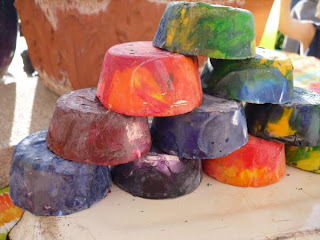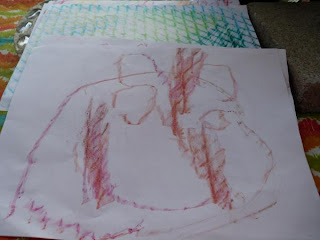The Tooth Fairy
I quietly explained that when babies are born, their mothers get a copy of the Mommy Handbook in the hospital, which had all of that information and a lot more. Of course, I couldn't show it to her, because she wasn't a Mommy yet, but when she got married and had her own kids, she'd get a copy and we could talk about it. Until then, it was all very hush-hush.What the Mommy Handbook may look like
My copy of the Handbook is pretty dog-eared now, covered in unidentifiable stains. But its full of all sorts of great information, suggestions, recipes, and activities, and has lasted me through two-and-a-quarter childhoods (so far). The margins are full of notes, and late additions have been stapled to the back cover. Directions for kissing away the pain of ouchies, and the recipe for Making It All Better. The recipe for Monster-banning spray, Thanksgiving dinner, and the instructions for Hiding Birthday Presents So That They Cannot Be Found.
And there is this, How to Recycle Crayons. I'm pretty sure every mom does this with or for their kids at least once. It's cheap, and simple. The results are fun and a lot more interesting than "regular" crayons. They make great gifts at Christmas and for birthdays. There are probably as many ways to do this as there are moms. This is how we did it.
from here, used with permission(^)
Step 1. Sort through your child's crayons periodically, removing all of the broken pieces. When you have enough to make new crayons, spend an evening reading or watching a movie and peeling off all those fiddly label bits. I've read that soaking them off works well, but it didn't work for me at all. This is a mind-numbingly tedious task, but I found that I settled into a grove while watching a movie and before long, it was all done with a satisfying pile of naked crayon bits in one bowl, and a pile of paper in the other.
Some of our recycled crayons
If you haven't the patience or the time to wait until you have hundreds of broken bits, you can usually find crayons in bags at the thrift store for nearly nothing. You could also ask your local restaurant to save them for you if they do that sort of thing. My one thought on these methods of acquisition is this: we buy crayons which are made in the United States because we're not sure about the dyes and coloring used in those made overseas. They may be safe, but there have been so many recalls that we choose not to risk it. Starting next month (late July) crayons will be incredibly cheap due to the back-to-school sales, so if you want to make enough for gifts or don't have the patience to wait for all of yours to break, that will be a great time to find them for practically nothing.We did a combination of the first suggestion (save out broken crayons) and the last (bought new) when we realized that our daughter doesn't break them fast enough. I bought new during the back-to-school supply sale last August. Boxes of 48 crayons were 11 cents each. My guess is that we used about 150 crayons, 50-ish broken an old, 96 (2 boxes worth) new. The cost, since we always stock up every summer for the following year, was maybe 35 cents, not counting the energy from the oven.
Step 2. With all of the crayons peeled, we rinsed the broken bits to get rid of any errant cat fur, since kitty is shedding right now. They drained over night on a piece of toweling in the kitchen. You can discard the paper, or do what I did, which is to save it for making new paper. The pieces will add colorful flecks to new sheets. Making paper is another project for another day, of course.
Step 3. The next day, we sorted the crayons into greased muffin tins. We talked about what the colors combinations reminded us of as we sorted. We made sure that all of the crayons were broken up into small bits, and broke any that looked big. Large pieces leave a lot of space in container, and will result is smaller crayons. We wanted big, strong shapes which would hold up to lots of coloring.
We combined yellows, reds and oranges to make an Autumn crayon. Pale blues and white for a Winter crayon. Pastels for a Spring crayon. Greens and yellows for a Summer crayon.
We mixed mixed greens and blues to make an ocean crayon. Black, purples, and blues to make a stormy night crayon. Pinks, purples and reds made a lovely Valentines crayon. Blues, greens, and purples for a crayon that reminded us of deep space. Browns, reds and oranges for an earth colored crayon. We ended up with a total of 14, all different.
Step 4. The soon-to-be-new-crayons can be microwaved in a safe container and poured into silicone molds. They can be melted over a double boiler and poured into molds. They can be placed in their mold in a slow-cooker and melted that way. And they can be placed in the oven in greased (and possibly papered) muffin tins with the oven on. I chose this method.
Even though we have a couple of silicone molds, I read that some molds have a bad habit of melting from the heat of the wax. I don't know which will and which won't, but didn't want to take the chance just now, because we want to try to mold chalk with later this month (page 486 in the Mommy Handbook).
Step 5. We greased our muffin tins. We should have used foil or paper liners. Please use foil or paper liners. Take my word for it. They should also be greased well. Don't use your vintage cast iron muffin tin (like I did), because when crayon gets on them, it'll take forever to get it out and you'll end up kicking yourself (like I did). Use "tin" muffin tins - the aluminum kind. If the worst happens, they'll be much easier to clean.
Step 6. After the muffin tins are lined and the crayons are sorted (we sorted the broken pieces all the way to the top of the rim of the tin) place the tins in an oven which has been heated to 275F. Due to our daughter's age, this was something that I did by myself. I started checking progress at around 10 minutes, and removed the molten pools of liquid wax at around the 14 minute point. You know your stove best, so start checking on the low end of when they may be done. "Done" means that the crayons are melted. The wax will be pooled in the tin, but won't be particularly well-mixed. This was the effect we were looking for - crayons which could color in more than one shade at once. If you'd like a more uniform effect, a light stir with a wooden skewer as soon as they come out of the oven would accomplish this, but might muddy the colors.
Our ocean crayon in an old enamel pan
Step 7. Turn off the oven, and wait 30 minutes or until the wax is entirely set. If you absolutely need them as quickly as possible, you could put the muffin tins in the fridge for a while. I didn't want to risk it since I didn't like the picture that hot, heavy cast iron and cold, glass fridge shelves conjured up. Besides, at out house, it was bed time by this point in the process, so we decided to leave our creations until the following morning. Step 8. Remove crayons from their mold. The next morning, because I hadn't used liners, I had a heck of a time thinking of how to get the crayons out of the tins. I tried popping them in the freezer, which didn't work. I didn't want to pry them out, and finally figured out that if I poured very hot water from the sink onto the backs of the tins, the crayons would loosen up and pop out. The cast iron tin ended up with a thin later of crayon on the inside To get it off, I eventually resorted to having my husband burn it out upside down on the gas grill after dinner. It worked and the tin is fine, but it would have been sooooo much easier to line the tins.
Step 9. Enjoy! As soon as my husband got home, he joined us on the back deck with paper and our new crayons. We colored and drew and had a lovely time.
Breaking in our new crayons
A very happy bunny
details from a picture of the ocean.
the pattern is caused by the wrought iron table we were working on,
not by the crayons.
Probably a famous art critic in disguise
Namaste.
=^..^=










